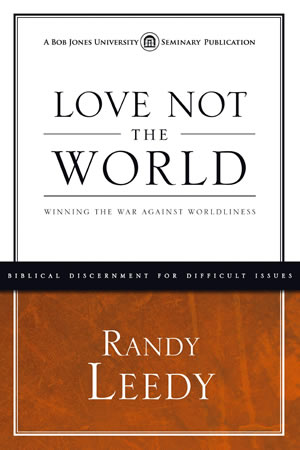
Love Not the World
Description : This work was written specifically to fundamentalists with two goals in mind: to be a “biblical theology of the world and worldliness” and to develop a contemporary application for the reader.
Part One of the book is “Defining the World.” Leedy begins with an Old Testament definition of “world.” While the term appears frequently in the Old Testament, Leedy notes that “world” generally refers to the created world. Instead of “world,” he suggests that the terms “Gentiles” (or “nations”) and “peoples” are the Old Testament terms for “world” in the sense of the lost, those who are estranged from God. Although acknowledging that the Old Testament does not particularly develop the theme of “worldliness,” it does demonstrate the narrowing of God’s choice of a people for himself to a specific family and then nation. The Old Testament also demonstrates what happens to the nations who oppose God’s righteousness and God’s people, as well as what happens when God’s own people, the nation of Israel, fail to obey. This is particularly evident in the Old Testament as Israel sought frequently to be like the nations around them, both politically and especially religiously.
Leedy then moves to a New Testament definition of “world” and “worldliness.” He notes that there are similar¬ities between the testaments: the Gentile nations are still present in the New Testament and still a source of ungodliness; salvation is brought to the nations through the Messiah; God’s people need to bring light to the Gentiles in darkness.
There is an expansion in the New Testament, however. The New Testament shifts terms from “nations” to “world.” Israel had a national identity, and “nations” fit well. The church does not have a national identity, so there is no separation from “nations” per se. The freedom of Gentiles to join the church without first becoming Jews was difficult for the early Jewish church to understand. While Peter was the first to take the Gospel to the Gentiles, Paul was the missionary whose focus was Gentilic.
Leedy examines kosmos (“world”) and aion (“age”), demonstrating the similarities and differences between the two terms, focusing primarily on the moral usages of the terms. Leedy also notes that the world is antagonistic to Christians because of the Satanic foundations to the world. As the “god of this age” he blinds and hardens people to the Gospel. Paul contrasted the “spirit of this world” with the “spirit of God.” There is a dichotomy between the divine nature and the fallen human nature.
Leedy then shifts his attention from definitions to discernment (“Discerning the World”). This section is based on four summary facts: 1) the world exists, 2) the world is all around us and, in our fallen flesh, within us, 3) the Father has rescued us from this world, 4) our Father commands us not to imitate the world. The remainder of this section focuses on Ephesians 4:17-5:21, Titus 2-3, 1 Peter 2:11-18, 1 Peter 4:3-5, and Matthew 6.
The remainder of the book focuses on the application of biblical principles concerning the “world.” Chapter 4 centers its attention on issues in the culture that are not explicitly addressed in Scripture. Leedy does not deal with specific activities, but focuses on the means of applying biblical principles. Chapter 5 centers its attention on how to develop principles concerning worldliness. How do we transfer the Bible’s teachings directly to our culture? How do we narrow the Bible’s generalities to our culture’s specifics? How do we expand the Bible’s specifics to related issues in our culture? How do we translate the Bible’s specifics to our culture’s specifics?
Whether you agree with Leedy’s conclusions or not, grappling with his approach will aid anyone in their struggle with the world and will especially help pastors as they teach their people the necessity of a godly life.


